air conditioning TOYOTA PRIUS PLUG-IN HYBRID 2017 Owners Manual
[x] Cancel search | Manufacturer: TOYOTA, Model Year: 2017, Model line: PRIUS PLUG-IN HYBRID, Model: TOYOTA PRIUS PLUG-IN HYBRID 2017Pages: 744, PDF Size: 84.41 MB
Page 4 of 744
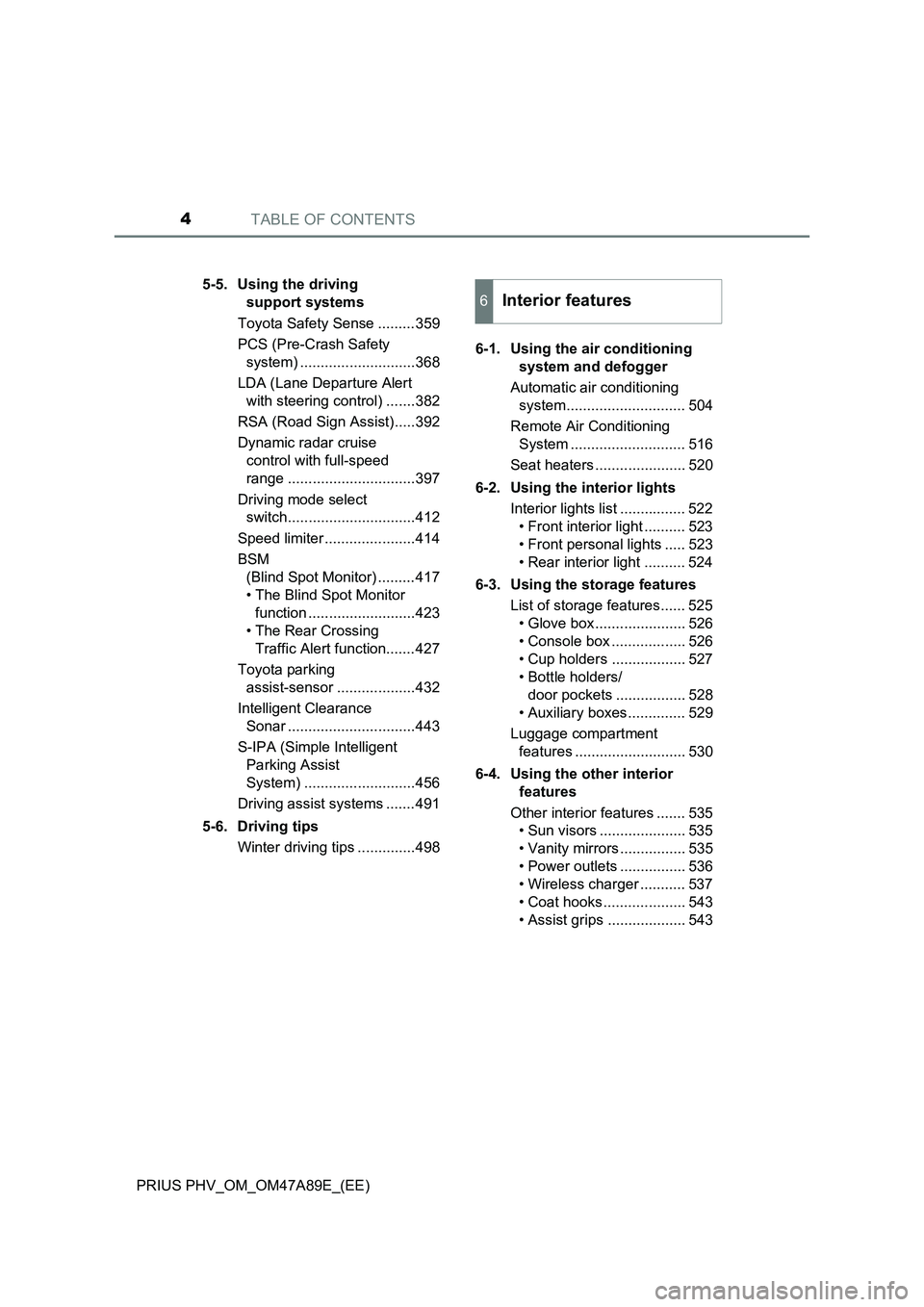
TABLE OF CONTENTS4
PRIUS PHV_OM_OM47A89E_(EE)5-5. Using the driving
support systems
Toyota Safety Sense .........359
PCS (Pre-Crash Safety
system) ............................368
LDA (Lane Departure Alert
with steering control) .......382
RSA (Road Sign Assist).....392
Dynamic radar cruise
control with full-speed
range ...............................397
Driving mode select
switch...............................412
Speed limiter ......................414
BSM
(Blind Spot Monitor) .........417
• The Blind Spot Monitor
function ..........................423
• The Rear Crossing
Traffic Alert function.......427
Toyota parking
assist-sensor ...................432
Intelligent Clearance
Sonar ...............................443
S-IPA (Simple Intelligent
Parking Assist
System) ...........................456
Driving assist systems .......491
5-6. Driving tips
Winter driving tips ..............4986-1. Using the air conditioning
system and defogger
Automatic air conditioning
system............................. 504
Remote Air Conditioning
System ............................ 516
Seat heaters ...................... 520
6-2. Using the interior lights
Interior lights list ................ 522
• Front interior light .......... 523
• Front personal lights ..... 523
• Rear interior light .......... 524
6-3. Using the storage features
List of storage features...... 525
• Glove box ...................... 526
• Console box .................. 526
• Cup holders .................. 527
• Bottle holders/
door pockets ................. 528
• Auxiliary boxes .............. 529
Luggage compartment
features ........................... 530
6-4. Using the other interior
features
Other interior features ....... 535
• Sun visors ..................... 535
• Vanity mirrors ................ 535
• Power outlets ................ 536
• Wireless charger ........... 537
• Coat hooks .................... 543
• Assist grips ................... 543
6Interior features
Page 5 of 744

5
1
9
8
7
6
5
4
2
PRIUS PHV_OM_OM47A89E_(EE)
3
7-1. Maintenance and care
Cleaning and protecting
the vehicle exterior ..........546
Cleaning and protecting
the vehicle interior ...........551
7-2. Maintenance
Maintenance
requirements....................557
7-3. Do-it-yourself maintenance
Do-it-yourself service
precautions ......................560
Hood ..................................563
Positioning a floor jack .......565
Engine compartment..........566
Tires ...................................580
Tire inflation pressure ........592
Wheels ...............................594
Replacing the tire ...............597
Air conditioning filter ..........609
Wiper rubber
replacement .....................613
Electronic key battery ........616
Checking and replacing
fuses ................................619
Light bulbs .........................623
8-1. Essential information
Emergency flashers .......... 632
If your vehicle has to
be stopped in an
emergency ...................... 633
8-2. Steps to take in an
emergency
If your vehicle needs
to be towed ..................... 634
If you think something is
wrong .............................. 640
If a warning light turns on
or a warning buzzer
sounds ............................ 641
If a warning message is
displayed ......................... 650
If you have a flat tire .......... 658
If the hybrid system will
not start ........................... 676
If the electronic key does
not operate properly ........ 678
If the 12-volt battery is
discharged ...................... 682
If your vehicle
overheats ........................ 688
If the vehicle becomes
stuck................................ 693
7Maintenance and care8When trouble arises
Page 17 of 744
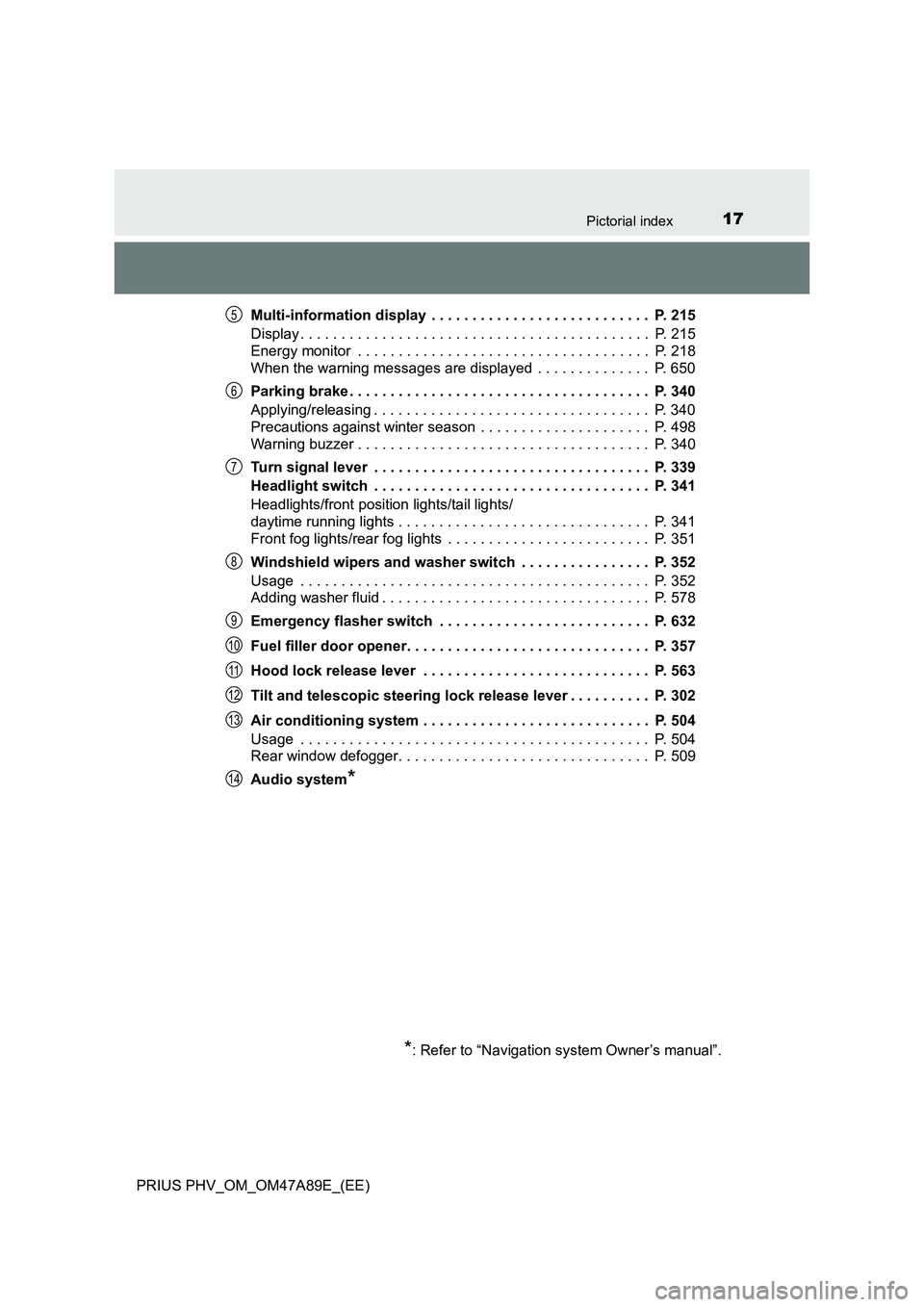
17Pictorial index
PRIUS PHV_OM_OM47A89E_(EE)Multi-information display . . . . . . . . . . . . . . . . . . . . . . . . . . . P. 215
Display . . . . . . . . . . . . . . . . . . . . . . . . . . . . . . . . . . . . . . . . . . . P. 215
Energy monitor . . . . . . . . . . . . . . . . . . . . . . . . . . . . . . . . . . . . P. 218
When the warning messages are displayed . . . . . . . . . . . . . . P. 650
Parking brake . . . . . . . . . . . . . . . . . . . . . . . . . . . . . . . . . . . . . P. 340
Applying/releasing . . . . . . . . . . . . . . . . . . . . . . . . . . . . . . . . . . P. 340
Precautions against winter season . . . . . . . . . . . . . . . . . . . . . P. 498
Warning buzzer . . . . . . . . . . . . . . . . . . . . . . . . . . . . . . . . . . . . P. 340
Turn signal lever . . . . . . . . . . . . . . . . . . . . . . . . . . . . . . . . . . P. 339
Headlight switch . . . . . . . . . . . . . . . . . . . . . . . . . . . . . . . . . . P. 341
Headlights/front position lights/tail lights/
daytime running lights . . . . . . . . . . . . . . . . . . . . . . . . . . . . . . . P. 341
Front fog lights/rear fog lights . . . . . . . . . . . . . . . . . . . . . . . . . P. 351
Windshield wipers and washer switch . . . . . . . . . . . . . . . . P. 352
Usage . . . . . . . . . . . . . . . . . . . . . . . . . . . . . . . . . . . . . . . . . . . P. 352
Adding washer fluid . . . . . . . . . . . . . . . . . . . . . . . . . . . . . . . . . P. 578
Emergency flasher switch . . . . . . . . . . . . . . . . . . . . . . . . . . P. 632
Fuel filler door opener. . . . . . . . . . . . . . . . . . . . . . . . . . . . . . P. 357
Hood lock release lever . . . . . . . . . . . . . . . . . . . . . . . . . . . . P. 563
Tilt and telescopic steering lock release lever . . . . . . . . . . P. 302
Air conditioning system . . . . . . . . . . . . . . . . . . . . . . . . . . . . P. 504
Usage . . . . . . . . . . . . . . . . . . . . . . . . . . . . . . . . . . . . . . . . . . . P. 504
Rear window defogger. . . . . . . . . . . . . . . . . . . . . . . . . . . . . . . P. 509
Audio system
*
*
: Refer to “Navigation system Owner’s manual”.
5
6
7
8
9
10
11
12
13
14
Page 23 of 744
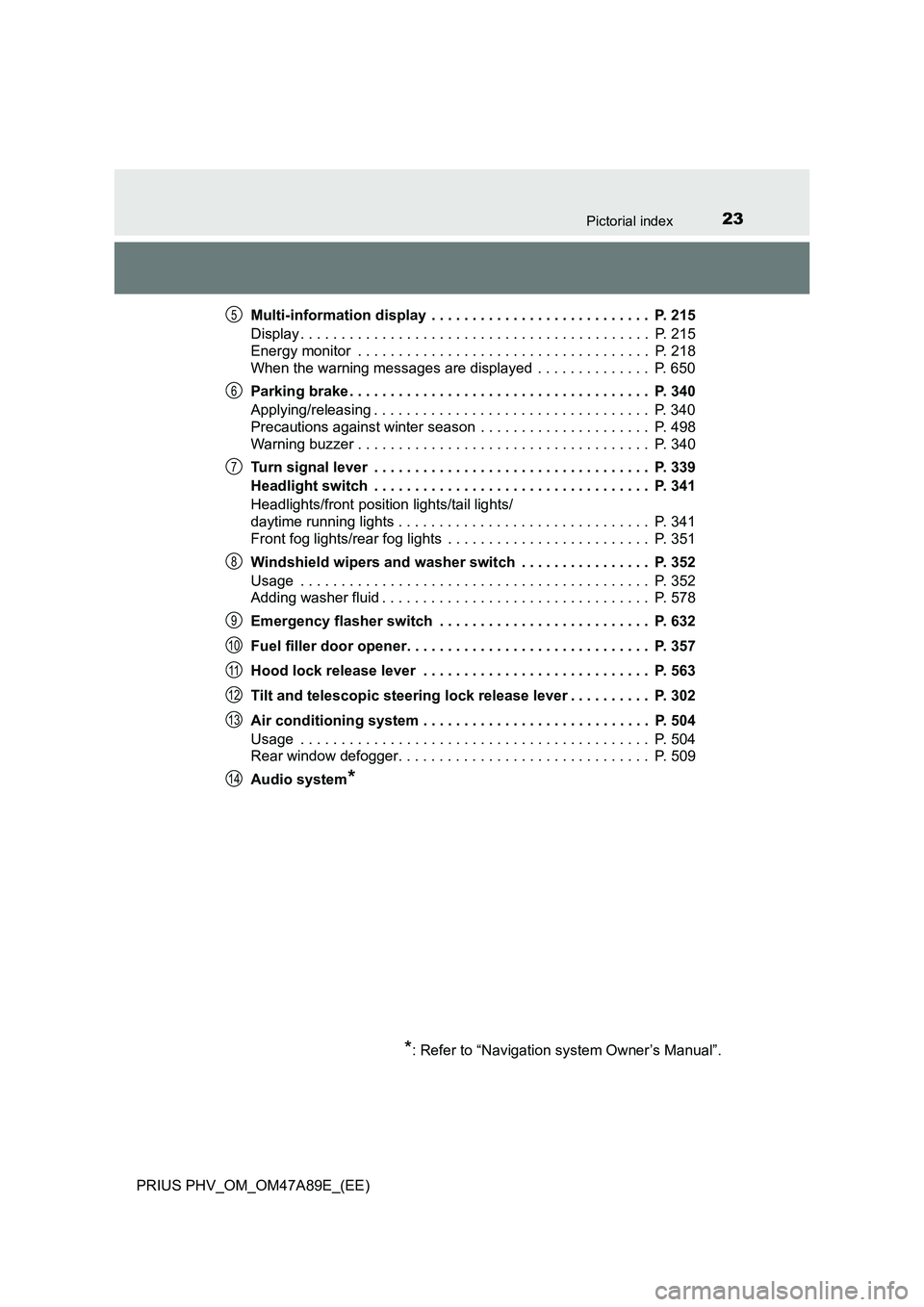
23Pictorial index
PRIUS PHV_OM_OM47A89E_(EE)Multi-information display . . . . . . . . . . . . . . . . . . . . . . . . . . . P. 215
Display . . . . . . . . . . . . . . . . . . . . . . . . . . . . . . . . . . . . . . . . . . . P. 215
Energy monitor . . . . . . . . . . . . . . . . . . . . . . . . . . . . . . . . . . . . P. 218
When the warning messages are displayed . . . . . . . . . . . . . . P. 650
Parking brake . . . . . . . . . . . . . . . . . . . . . . . . . . . . . . . . . . . . . P. 340
Applying/releasing . . . . . . . . . . . . . . . . . . . . . . . . . . . . . . . . . . P. 340
Precautions against winter season . . . . . . . . . . . . . . . . . . . . . P. 498
Warning buzzer . . . . . . . . . . . . . . . . . . . . . . . . . . . . . . . . . . . . P. 340
Turn signal lever . . . . . . . . . . . . . . . . . . . . . . . . . . . . . . . . . . P. 339
Headlight switch . . . . . . . . . . . . . . . . . . . . . . . . . . . . . . . . . . P. 341
Headlights/front position lights/tail lights/
daytime running lights . . . . . . . . . . . . . . . . . . . . . . . . . . . . . . . P. 341
Front fog lights/rear fog lights . . . . . . . . . . . . . . . . . . . . . . . . . P. 351
Windshield wipers and washer switch . . . . . . . . . . . . . . . . P. 352
Usage . . . . . . . . . . . . . . . . . . . . . . . . . . . . . . . . . . . . . . . . . . . P. 352
Adding washer fluid . . . . . . . . . . . . . . . . . . . . . . . . . . . . . . . . . P. 578
Emergency flasher switch . . . . . . . . . . . . . . . . . . . . . . . . . . P. 632
Fuel filler door opener. . . . . . . . . . . . . . . . . . . . . . . . . . . . . . P. 357
Hood lock release lever . . . . . . . . . . . . . . . . . . . . . . . . . . . . P. 563
Tilt and telescopic steering lock release lever . . . . . . . . . . P. 302
Air conditioning system . . . . . . . . . . . . . . . . . . . . . . . . . . . . P. 504
Usage . . . . . . . . . . . . . . . . . . . . . . . . . . . . . . . . . . . . . . . . . . . P. 504
Rear window defogger. . . . . . . . . . . . . . . . . . . . . . . . . . . . . . . P. 509
Audio system
*
*
: Refer to “Navigation system Owner’s Manual”.
5
6
7
8
9
10
11
12
13
14
Page 88 of 744
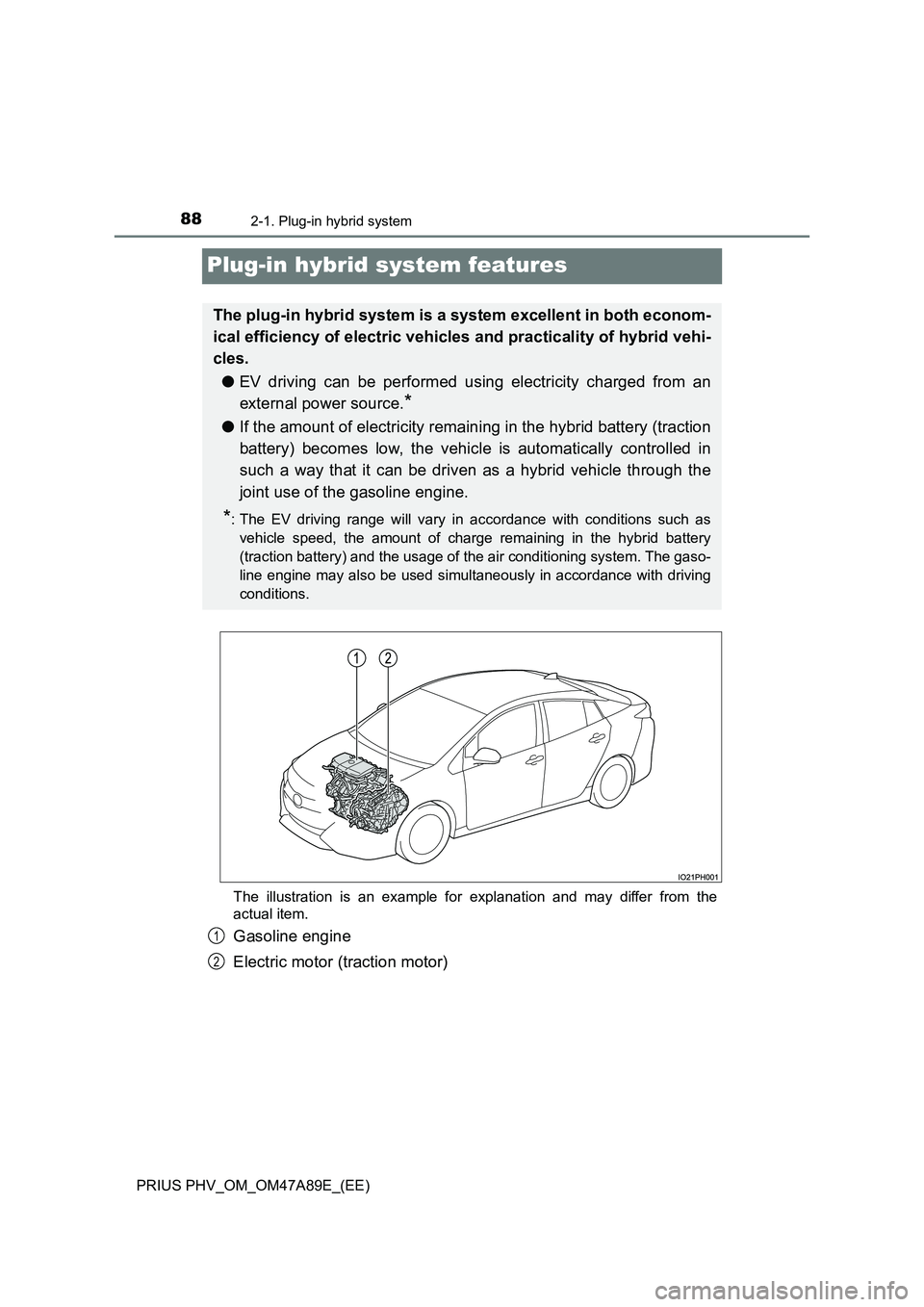
882-1. Plug-in hybrid system
PRIUS PHV_OM_OM47A89E_(EE)
Plug-in hybrid system features
The illustration is an example for explanation and may differ from the
actual item.
Gasoline engine
Electric motor (traction motor)
The plug-in hybrid system is a system excellent in both econom-
ical efficiency of electric vehicles and practicality of hybrid vehi-
cles.
● EV driving can be performed using electricity charged from an
external power source.*
● If the amount of electricity remaining in the hybrid battery (traction
battery) becomes low, the vehicle is automatically controlled in
such a way that it can be driven as a hybrid vehicle through the
joint use of the gasoline engine.
*: The EV driving range will vary in accordance with conditions such as
vehicle speed, the amount of charge remaining in the hybrid battery
(traction battery) and the usage of the air conditioning system. The gaso-
line engine may also be used simultaneously in accordance with driving
conditions.
1
2
Page 94 of 744
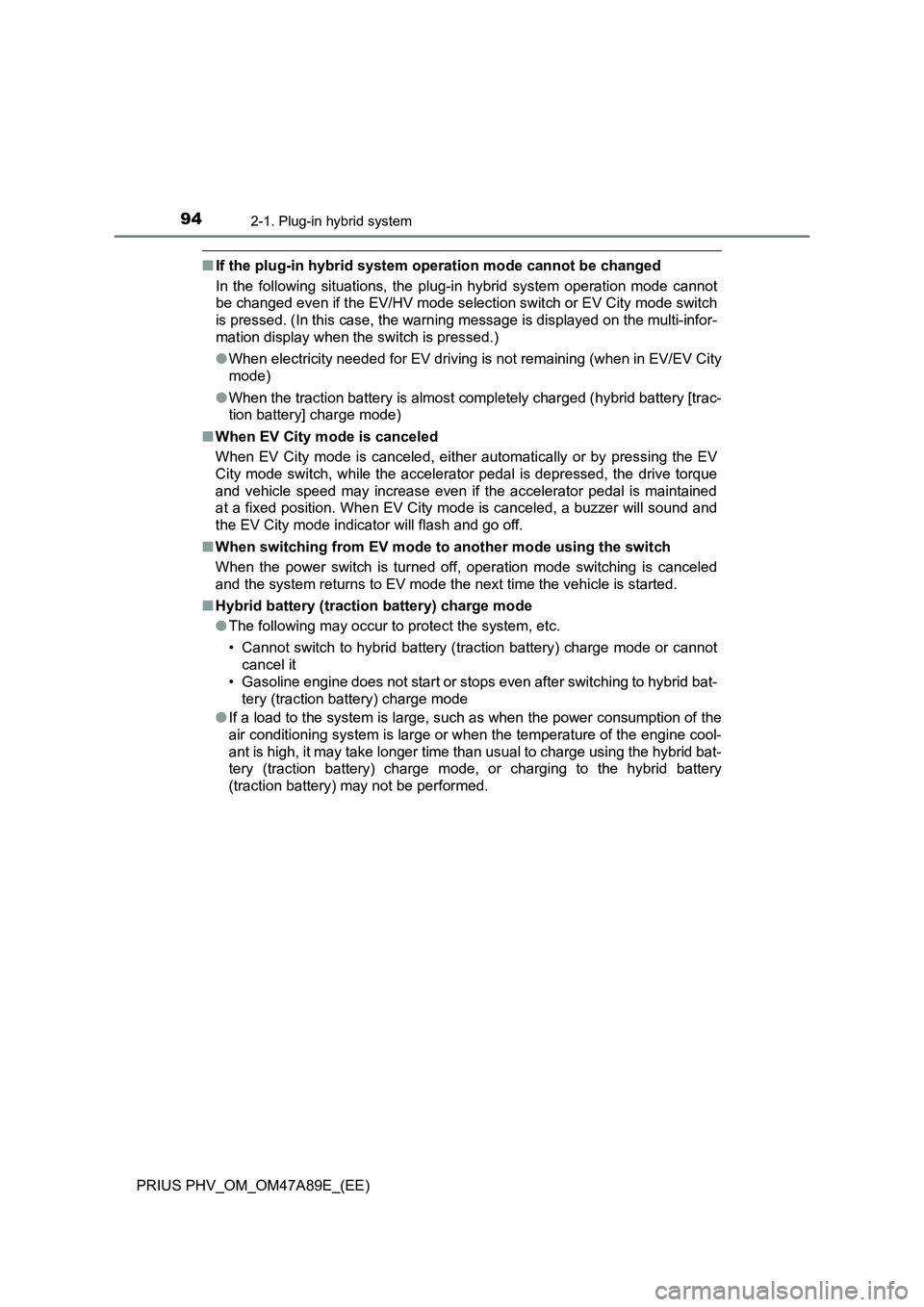
942-1. Plug-in hybrid system
PRIUS PHV_OM_OM47A89E_(EE)
■If the plug-in hybrid system operation mode cannot be changed
In the following situations, the plug-in hybrid system operation mode cannot
be changed even if the EV/HV mode selection switch or EV City mode switch
is pressed. (In this case, the warning message is displayed on the multi-infor-
mation display when the switch is pressed.)
●When electricity needed for EV driving is not remaining (when in EV/EV City
mode)
●When the traction battery is almost completely charged (hybrid battery [trac-
tion battery] charge mode)
■When EV City mode is canceled
When EV City mode is canceled, either automatically or by pressing the EV
City mode switch, while the accelerator pedal is depressed, the drive torque
and vehicle speed may increase even if the accelerator pedal is maintained
at a fixed position. When EV City mode is canceled, a buzzer will sound and
the EV City mode indicator will flash and go off.
■When switching from EV mode to another mode using the switch
When the power switch is turned off, operation mode switching is canceled
and the system returns to EV mode the next time the vehicle is started.
■Hybrid battery (traction battery) charge mode
●The following may occur to protect the system, etc.
• Cannot switch to hybrid battery (traction battery) charge mode or cannot
cancel it
• Gasoline engine does not start or stops even after switching to hybrid bat-
tery (traction battery) charge mode
●If a load to the system is large, such as when the power consumption of the
air conditioning system is large or when the temperature of the engine cool-
ant is high, it may take longer time than usual to charge using the hybrid bat-
tery (traction battery) charge mode, or charging to the hybrid battery
(traction battery) may not be performed.
Page 101 of 744
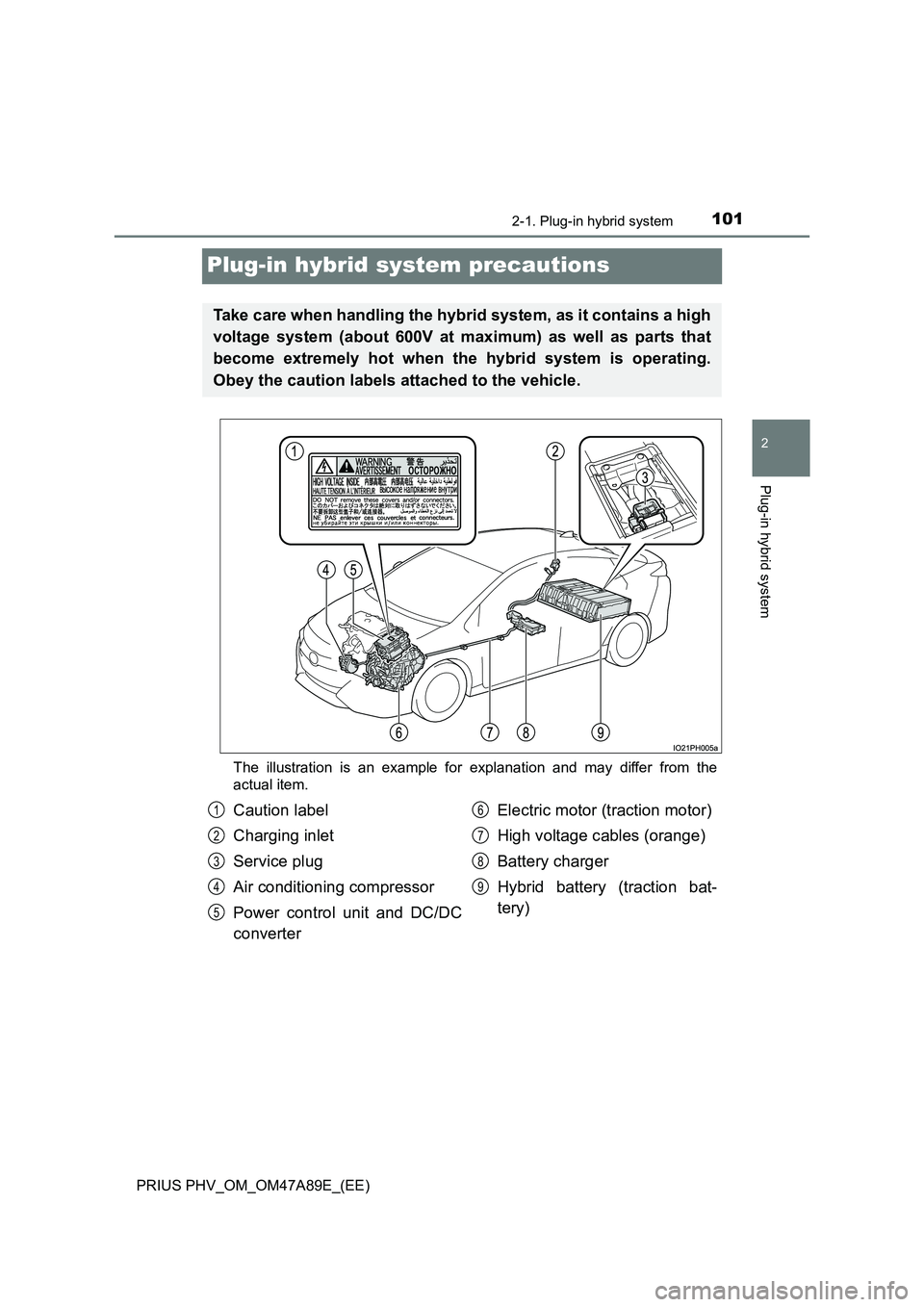
101
2
2-1. Plug-in hybrid system
Plug-in hybrid system
PRIUS PHV_OM_OM47A89E_(EE)
Plug-in hybrid system precautions
The illustration is an example for explanation and may differ from the
actual item.
Take care when handling the hybrid system, as it contains a high
voltage system (about 600V at maximum) as well as parts that
become extremely hot when the hybrid system is operating.
Obey the caution labels attached to the vehicle.
Caution label
Charging inlet
Service plug
Air conditioning compressor
Power control unit and DC/DC
converterElectric motor (traction motor)
High voltage cables (orange)
Battery charger
Hybrid battery (traction bat-
tery)1
2
3
4
5
6
7
8
9
Page 108 of 744
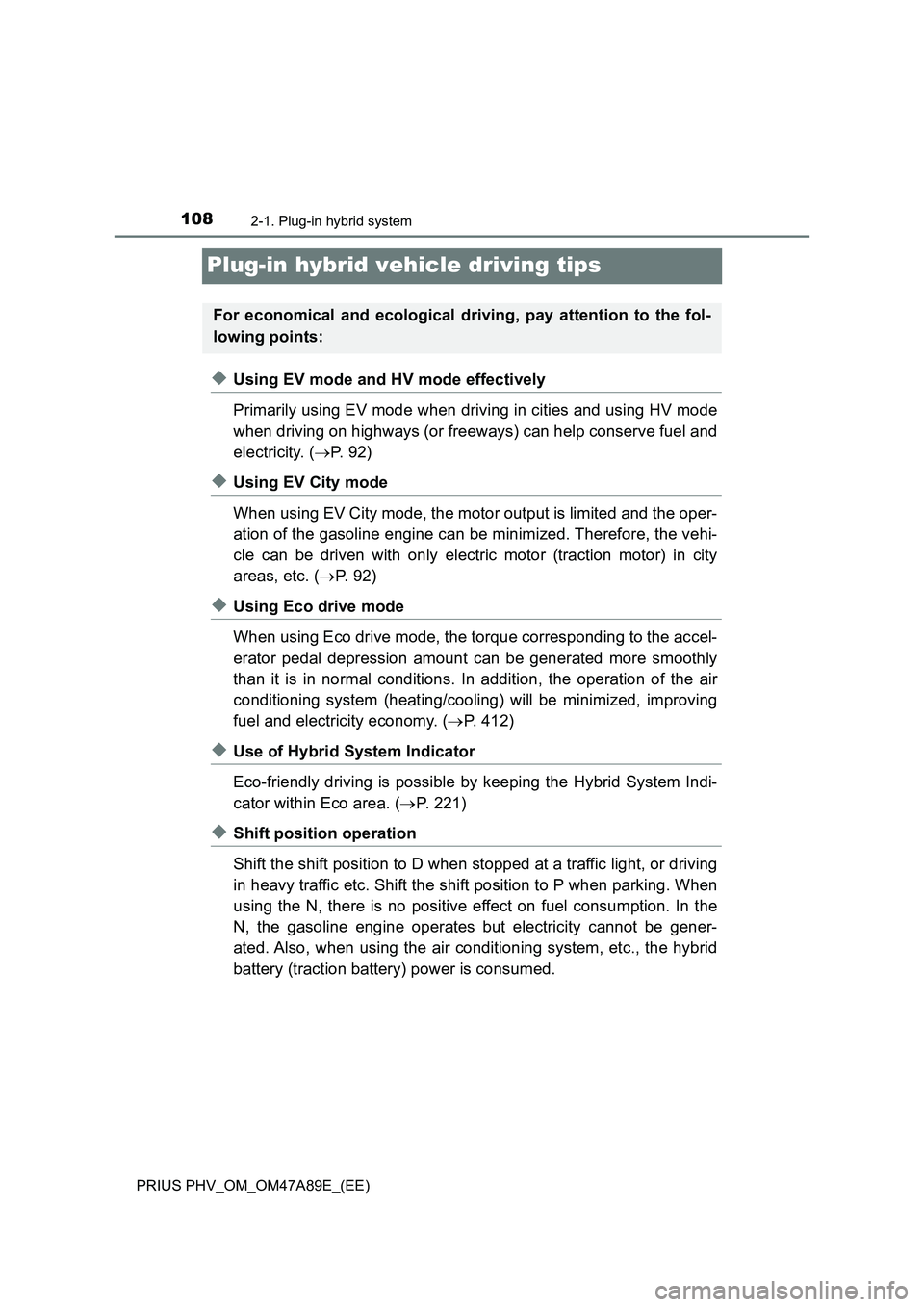
1082-1. Plug-in hybrid system
PRIUS PHV_OM_OM47A89E_(EE)
Plug-in hybrid vehicle driving tips
◆Using EV mode and HV mode effectively
Primarily using EV mode when driving in cities and using HV mode
when driving on highways (or freeways) can help conserve fuel and
electricity. (P. 92)
◆Using EV City mode
When using EV City mode, the motor output is limited and the oper-
ation of the gasoline engine can be minimized. Therefore, the vehi-
cle can be driven with only electric motor (traction motor) in city
areas, etc. (P. 92)
◆Using Eco drive mode
When using Eco drive mode, the torque corresponding to the accel-
erator pedal depression amount can be generated more smoothly
than it is in normal conditions. In addition, the operation of the air
conditioning system (heating/cooling) will be minimized, improving
fuel and electricity economy. (P. 412)
◆Use of Hybrid System Indicator
Eco-friendly driving is possible by keeping the Hybrid System Indi-
cator within Eco area. (P. 221)
◆Shift position operation
Shift the shift position to D when stopped at a traffic light, or driving
in heavy traffic etc. Shift the shift position to P when parking. When
using the N, there is no positive effect on fuel consumption. In the
N, the gasoline engine operates but electricity cannot be gener-
ated. Also, when using the air conditioning system, etc., the hybrid
battery (traction battery) power is consumed.
For economical and ecological driving, pay attention to the fol-
lowing points:
Page 110 of 744
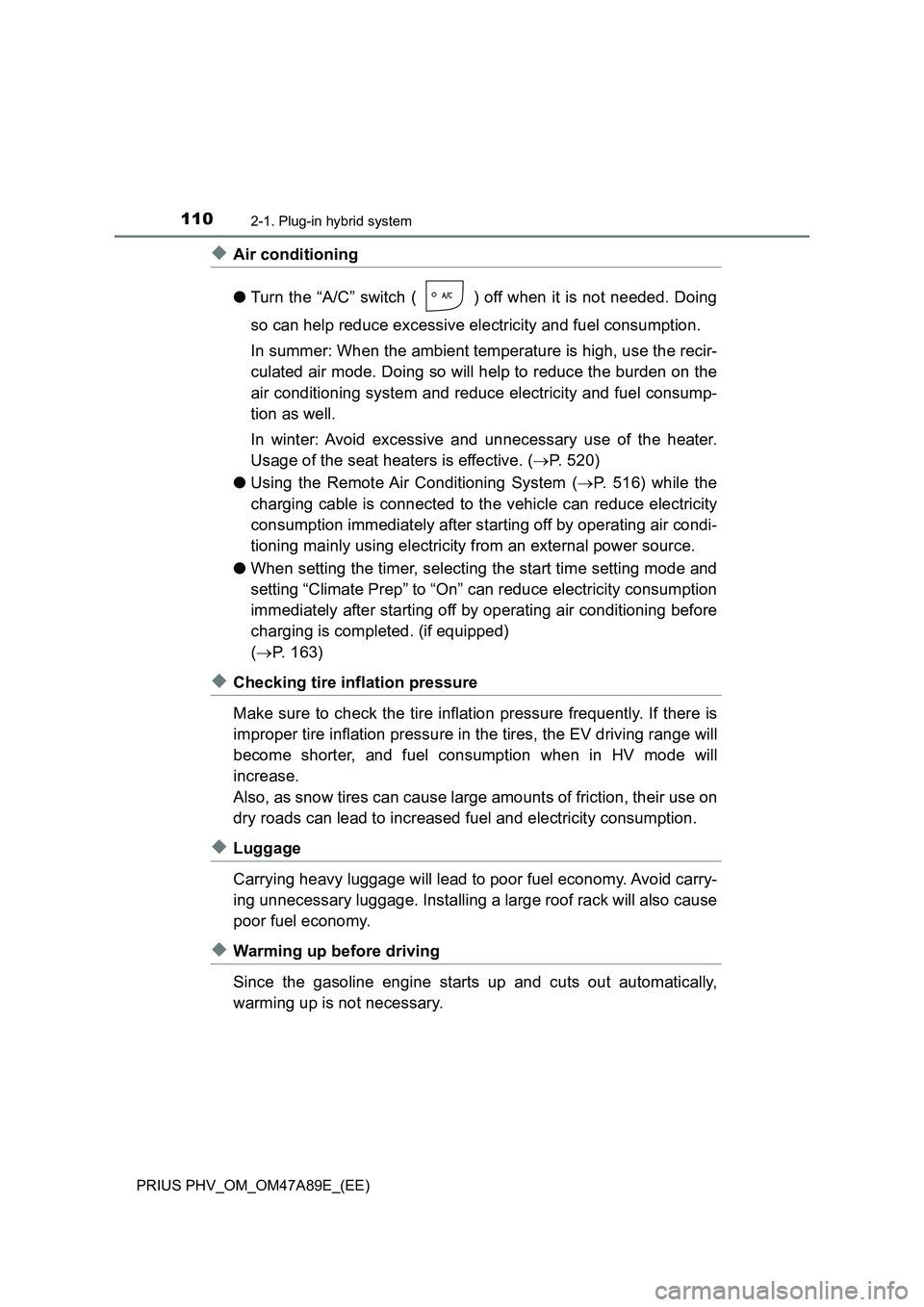
1102-1. Plug-in hybrid system
PRIUS PHV_OM_OM47A89E_(EE)
◆Air conditioning
●Turn the “A/C” switch ( ) off when it is not needed. Doing
so can help reduce excessive electricity and fuel consumption.
In summer: When the ambient temperature is high, use the recir-
culated air mode. Doing so will help to reduce the burden on the
air conditioning system and reduce electricity and fuel consump-
tion as well.
In winter: Avoid excessive and unnecessary use of the heater.
Usage of the seat heaters is effective. (P. 520)
●Using the Remote Air Conditioning System (P. 516) while the
charging cable is connected to the vehicle can reduce electricity
consumption immediately after starting off by operating air condi-
tioning mainly using electricity from an external power source.
●When setting the timer, selecting the start time setting mode and
setting “Climate Prep” to “On” can reduce electricity consumption
immediately after starting off by operating air conditioning before
charging is completed. (if equipped)
(P. 163)
◆Checking tire inflation pressure
Make sure to check the tire inflation pressure frequently. If there is
improper tire inflation pressure in the tires, the EV driving range will
become shorter, and fuel consumption when in HV mode will
increase.
Also, as snow tires can cause large amounts of friction, their use on
dry roads can lead to increased fuel and electricity consumption.
◆Luggage
Carrying heavy luggage will lead to poor fuel economy. Avoid carry-
ing unnecessary luggage. Installing a large roof rack will also cause
poor fuel economy.
◆Warming up before driving
Since the gasoline engine starts up and cuts out automatically,
warming up is not necessary.
Page 111 of 744
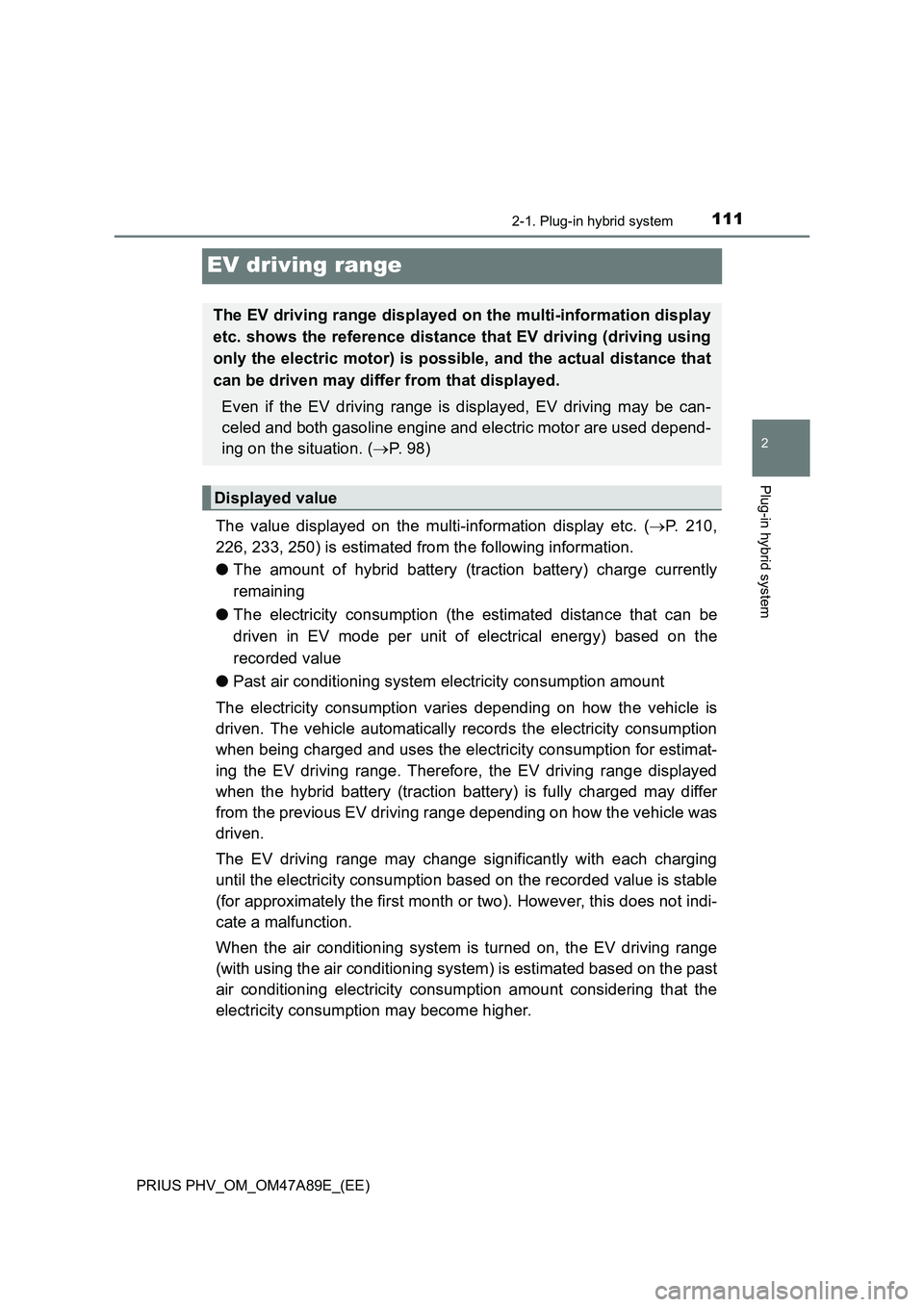
111
2
2-1. Plug-in hybrid system
Plug-in hybrid system
PRIUS PHV_OM_OM47A89E_(EE)
EV driving range
The value displayed on the multi-information display etc. (P. 210,
226, 233, 250) is estimated from the following information.
●The amount of hybrid battery (traction battery) charge currently
remaining
●The electricity consumption (the estimated distance that can be
driven in EV mode per unit of electrical energy) based on the
recorded value
●Past air conditioning system electricity consumption amount
The electricity consumption varies depending on how the vehicle is
driven. The vehicle automatically records the electricity consumption
when being charged and uses the electricity consumption for estimat-
ing the EV driving range. Therefore, the EV driving range displayed
when the hybrid battery (traction battery) is fully charged may differ
from the previous EV driving range depending on how the vehicle was
driven.
The EV driving range may change significantly with each charging
until the electricity consumption based on the recorded value is stable
(for approximately the first month or two). However, this does not indi-
cate a malfunction.
When the air conditioning system is turned on, the EV driving range
(with using the air conditioning system) is estimated based on the past
air conditioning electricity consumption amount considering that the
electricity consumption may become higher.
The EV driving range displayed on the multi-information display
etc. shows the reference distance that EV driving (driving using
only the electric motor) is possible, and the actual distance that
can be driven may differ from that displayed.
Even if the EV driving range is displayed, EV driving may be can-
celed and both gasoline engine and electric motor are used depend-
ing on the situation. (P. 9 8 )
Displayed value